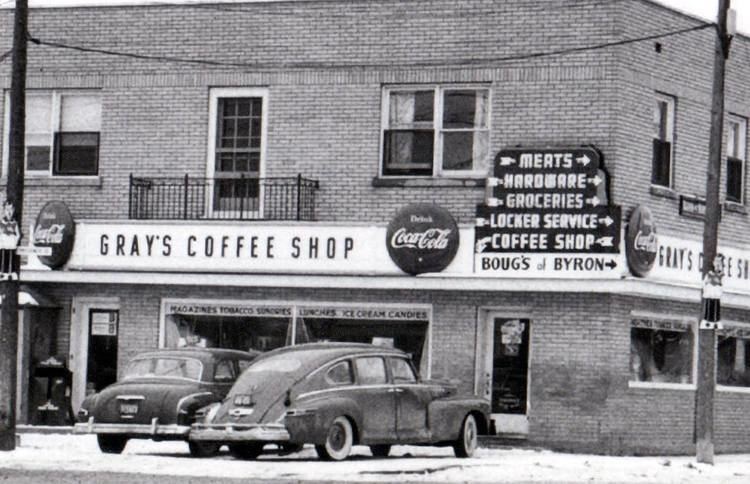Country Canada Settled 1880 (as Westminster) Amalgamation (city) 1961 (as London) Population 15,525 (2011) Province Ontario | City London Incorporated (village) 1804 (as Hall's Mill) Elevation 254 m Area code Area codes 519 and 226 | |
 | ||
Time zone Eastern Time Zone (UTC-5) Restaurants Bernie's Bar & Grill, Byron Freehouse, Waldo's In Byron, Byron Pizza, Porcino | ||
Byron is a neighbourhood in the City of London, Ontario, Canada. It is adjacent to the Thames River in the south-west of London. Almost all of its residents live in low-density, single detached dwellings. As of 2011, the area is home to 15,525 residents. The neighbourhood is considered a middle-income area, with an average family income of $64,525 an average dwelling value of $312,896 and a home ownership rate of 93%.
Contents
- Map of Byron London ON Canada
- History
- Government and politics
- Elementary schools
- Secondary schools
- Private schools
- Attractions
- Byron Telephone Company
- Location
- Tim Hortons controversy
- Notable Byronites
- References
Map of Byron, London, ON, Canada
History
Byron was originally called Westminster, then renamed Hall's Mill, and then finally Byron. The Byron area was settled in 1800 and first became a village in 1804. In March 7 1961, it was annexed by the city of London and the population grew substantially with the development of large subdivisions around the original village.
Government and politics
Byron exists within the federal electoral district of London West. It is currently represented by Kate Young of the Liberal Party of Canada, first elected in 2015.
Provincially, the area is within the constituency of London West. It is currently represented by Peggy Sattler of the New Democratic Party, first elected in 2013 and re-elected in 2014.
In London's non-partisan municipal politics, Byron lies within ward 9. It is currently represented by Councillor Anna Hopkins, first elected in 2014.
Elementary schools
There are six publicly funded elementary schools in Byron:
The first three schools are under the jurisdiction of the Thames Valley District School Board and the latter two are part of the London District Catholic School Board.
Secondary schools
There are no secondary schools located in Byron (a source of some consternation to residents, as a secondary school was originally promised by the city of London when Byron was annexed). Two publicly funded secondary schools serve the needs of Byron students. The nearest is St. Thomas Aquinas Catholic Secondary School in the London District Catholic School Board, to the north across the Thames River. This school primarily serves the needs of Roman Catholic students, though, as it is publicly funded, students of any religious denomination may attend. Most secondary school age students in Byron choose to attend Saunders Secondary School in the Thames Valley District School Board in the Westmount suburb of London. Though they do not live within the drawing area, a number of secondary school age children from Byron currently attend Oakridge Secondary School, located in the neighbourhood of Oakridge in London.
Private schools
There is one private (for profit) school in Byron. This is a Montessori pre-school, located on Commissioners Road between Grand View Ave and Chestnut Hill.
Attractions
Byron is home to Springbank Park, a picturesque urban park and the largest in London. It is also home to Storybook Gardens, a popular children's attraction open year-round. Byron also has Boler Mountain, a small co-operative that offers skiing, snowboarding, snow-tubing, and mountain bike terrains.
Byron hosted two cycling events during the 2001 Canada Summer Games; the mountain biking event on Boler Mountain, and the road cycling event, where cyclists raced through the heart of the village.
Byron Telephone Company
Byron was served until August 1960 by the Byron Telephone Company, when it was sold to Bell Canada. A manual telephone exchange continued to operate until September 15, 1963, and in 1962 or 1963, the short code 471 was introduced to London exchange customers for the convenience of immediately reaching the Byron operator to complete a call. Upon dial introduction, 471 became the exchange prefix.
However, some two or three years before 1960, the Byron Telephone Company converted its Lambeth-area customers to a dial exchange, the OLiver 2 exchange.
Location
The current boundaries of Byron are generally regarded to be the land south of the Thames River and west of Colonel Talbot Road. Recent housing developments have expanded Byron southward to Southdale Road and westward to Wickerson Road. Outside of the urban area, Byron is surrounded by farmland and forested areas. On the eastern border of Byron is the Byron Gravel Pit, the sixteenth-largest gravel pit in Canada. Historically, Byron also consisted of some land north of the Thames River in the area known today as Oakridge Park, including the Byron Bog (now Sifton Bog).
Tim Hortons controversy
In 2000, Tim Hortons, which had 44 locations throughout London, sought to open its first full-service location in Byron. At the time, Tim Hortons' presence in Byron was limited to a kiosk inside the A&P grocery store with no seating, limited hours, and a limited menu.
Tim Hortons was met by bitter opposition from a small group of members of the community, which had also stopped an entry by Tim Hortons into Byron in 1998. Some members of the group claimed building a Tim Hortons would ruin the "small-town atmosphere" that they claimed Byron to have by generating too much traffic and noise.
London City Council sided with local residents and refused to rezone a parcel of land along Commissioners Road to permit Tim Hortons to build a store there. TDL Group Ltd. appealed the decision to the Ontario Municipal Board (OMB), and the OMB sided with TDL and ordered the City to permit the required rezoning. [1] Tim Hortons opened its Byron location in December 2001.
